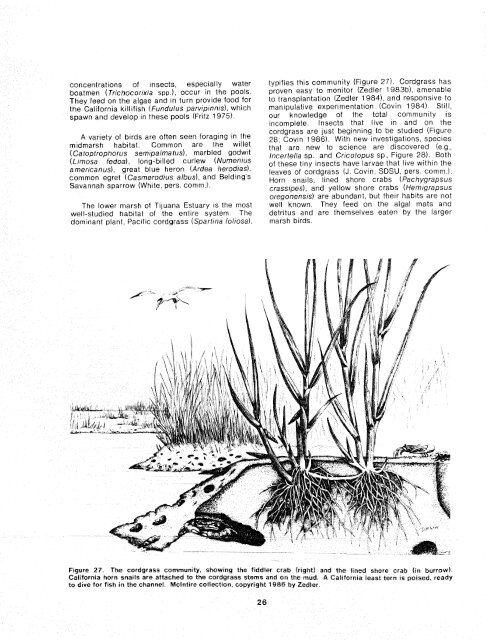The Ecology of Tijuana Estuary, California: An Estuarine Profile
The Ecology of Tijuana Estuary, California: An Estuarine Profile
The Ecology of Tijuana Estuary, California: An Estuarine Profile
Create successful ePaper yourself
Turn your PDF publications into a flip-book with our unique Google optimized e-Paper software.
c~n~entrations <strong>of</strong> insects, especially water<br />
boatmen (Tr,chocor,x/a spp 1, occur in the pools<br />
typifies this community (~~gure 271 Cordgrass has<br />
proven easy to monitor (Zedler 1983b), amenable<br />
<strong>The</strong>y feed on the algae and in turn provide food for to transplantation (Zedler 19841. and responsive to<br />
the Californta killtflsh (Fundulus parv~p~nn,~), which manipulative experimentation (~ovin 1984) still,<br />
spawn and develop in these pools (Fritz 1975) our knowledge <strong>of</strong> the total community is<br />
incomplete Insects that live in and on the<br />
cordgrass are just beginning to be studied (Figure<br />
A varletY <strong>of</strong> birds are <strong>of</strong>ten Seen foraging in the 28, covin ,986) with new species<br />
midmarsh hab~tat Common are the wlllet that are new to science are (e g ,<br />
(Catoptrophorus seml~almatus), marbled godwit /ncerte//a sp and Cr,cotopus sp , Figure 28) Both<br />
(Llm0Sa fedoa), long-billed curlew (Numenlus <strong>of</strong> these tiny have larvae that live w,thln the<br />
amencanus), great blue heron (Ardea herodtas), leaves <strong>of</strong> cordgrass (J covln, SDSU, pers comm )<br />
Common egret (Casrnerodlus albus), and Beldlng's H~~~ snails, lined shore crabs (Pachygrapsus<br />
Savannah sparrow (Wh~te, pers comm )<br />
crasslpes), and yellow shore crabs (Hemlgrapsus<br />
oregonens~s) are abundant, but their hab~ts are not<br />
<strong>The</strong> lower marsh <strong>of</strong> <strong>Tijuana</strong> <strong>Estuary</strong> is the most well known <strong>The</strong>y feed on the algal mats and<br />
well-studied habitat <strong>of</strong> the entire system <strong>The</strong> detrltus and are themselves eaten by the larger<br />
dominant plant, Pacif~ cordgrass (Spartlna fol~osa), marsh birds<br />
Figure 27. <strong>The</strong> cord~rass community. showing the fiddler crab (right) and the lined shore crab (in burrow).<br />
<strong>California</strong> horn snails are attached to the cordgrass stems and on the mud. A <strong>California</strong> least tern is poised, ready<br />
to dive for fish in the channel. Mclntire cotlection, copyright 1986 by Zedler.

















